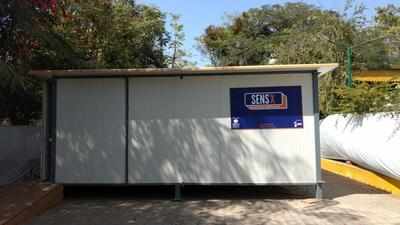- News
- City News
- ahmedabad News
- Empathize with deaf-blindness in world’s 1st interactive space
Trending
This story is from February 26, 2017
Empathize with deaf-blindness in world’s 1st interactive space

Ahmedabad: Picture this: You walk into a room and after two steps inside, you are past a curtain and you can’t see anything–there isn’t a single ray of light. There is ‘white noise’ in the background that is suppressing all other sounds around. Your only guide is the walls and things you can touch and the smells you can identify. The thought may either be intimidating, disturbing or even adventurous and beautiful.Such is the space designed by city-based space designer duo—Freyaan Anklesaria and Mirant Tiwari—to let people experience the life of a deaf-blind person for a few minutes. In fact, it is the world’s first interactive space to emulate deaf-blindness.
Known as ‘SenseX’, indicating Sensory Experience, the interactive space is created with a view to making people empathize with deaf-blindness, a disability even though long-prevailing in India, that was recognized as a disability in the last winter session of the Parliament with the new disabilities bill. At present, the installation of the experiential space is kept at the campus of Blind People’s Association.
“Deaf-blind people lose 95% of their input information as their receptive sensory organs are impaired. Our idea is not to let people get disturbed but rather let them experience the life of a deaf-blind person and see beauty through their eyes,” explained Freyaan, who is a city-based interior designer.
“The space is still being improvised with minor changes to make the experience more wholesome,” she added. The entire project is funded by Sense International India, an NGO which is working to address multi-sensory impairment, mainly deaf-blindness.
Known as ‘SenseX’, indicating Sensory Experience, the interactive space is created with a view to making people empathize with deaf-blindness, a disability even though long-prevailing in India, that was recognized as a disability in the last winter session of the Parliament with the new disabilities bill. At present, the installation of the experiential space is kept at the campus of Blind People’s Association.
“Deaf-blind people lose 95% of their input information as their receptive sensory organs are impaired. Our idea is not to let people get disturbed but rather let them experience the life of a deaf-blind person and see beauty through their eyes,” explained Freyaan, who is a city-based interior designer.
“The space is still being improvised with minor changes to make the experience more wholesome,” she added. The entire project is funded by Sense International India, an NGO which is working to address multi-sensory impairment, mainly deaf-blindness.
Sharing more details about the project, Mirant, who is the co-founder of Hats & Beards, a design agency, said, “Initially during the research phase, we looked for existing spaces that were designed to simulate deaf-blindness so that we get an idea to implement them better. While we came across experiential spaces for deafness and blindness separately, we did not come across a single one that lets one experience both.”
End of Article
FOLLOW US ON SOCIAL MEDIA










